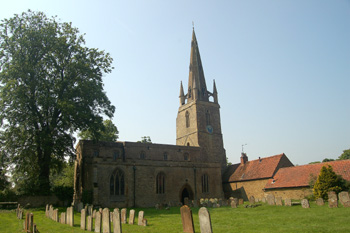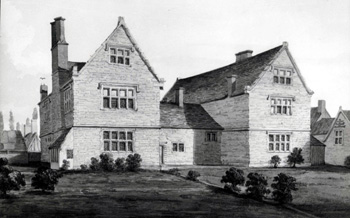
Harrold Church from the north - May 2008
Volume 81 published by Bedfordshire Historical Records Society (2002) is a series of episcopal visitations undertaken in the first twenty years of the 18th century, edited by former County Archivist Patricia Bell. At each visitation a list of questions was sent out in advance, one of which enquired about the provision of schools in each parish. The various replies for Harrold were as follows:
- 1706: "There is no Lecture, School, Almshouse, nor Hospital endowed within this parish";
- 1709: "No public or charity Schole";
- 1717: "No publick or charity school";
- 1720: "No publick school"
Just under a century later the Congregationalists were running a Sunday School; a document [X242] survives for the years 1809 to 1812 detailing the school rules and classes. In those days a Sunday School was just that, a school which met on a Sunday, usually in the church or nonconformist chapel or other similar building, teaching more than the religious topics with which they are associated today.

Mr Brown's School in Harrold about 1820 [Z102/41]
In 1818 a Select Committee was established to enquire into educational provision for the poor. This was no doubt prompted, in part, by the recent foundation of two societies promoting education and specifically the building of schools. The Society for Promoting the Lancasterian System for the Education of the Poor was established in 1808 promoting schools run along the lines pioneered by Joseph Lancaster, who had himself copied those of Dr. Andrew Bell, in which older children taught their younger fellows. The Society was renamed the British and Foreign School Society in 1814,. It was supported by a number of prominent nonconformists, Lancaster himself was a Quaker, and sought to teach a non-sectarian curriculum. In answer to this perceived nonconformist takeover of local education the National Society was formed in 1811 to encourage the teaching of poor children along Anglican lines, including the catechism. The Select Committee sent a questionnaire to all parishes in the country asking for: particulars relating to endowments for the education of children; other educational institutions; observations of parish needs etc. The Vicar of Harrold answered that there was no educational endowment in the village but that there were two Sunday Schools, containing together nearly a hundred children. There were also "Two or three small day schools" - one of which was probably Mr Brown's School, the subject of a surviving painting made around this time which seems to show that he held it in part of The Old Manor. Finally, the vicar noted: "The children are principally employed in lace-making".

Former Congregational Church Sunday School in May 2008
In the country generally the number of schools built continued to grow over the next fifteen years so that by 1833 the government agreed to supplement the work of the two societies, and local benefactors, by making £20,000 per annum available in grants to help build schools. It also prompted another questionnaire to be sent to each parish in England asking for details of local educational provision. The Harrold return stated: "Three Infant Schools containing 24 boys and 25 girls; and Two Daily Schools, of 41 boys and 11 girls; all supported by payments from the parents. Two Sunday Schools, one of the Established Church, at which are 103 children of both sexes; the other, consisting of 138 children, supported by the voluntary contributions of those who form an Independent congregation"; the latter clearly referred to the Congregationalists.
Pigot & Company's Directory for 1839 has a section for Harrold. Mr Brown's School is not mentioned (the only Brown noted is Joseph M.B.Brown, solicitor). However, Rev. Richard M.Worth's boarding and day academy is listed. Later private schools in the village, noted in directories, are as follows: